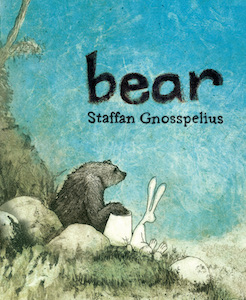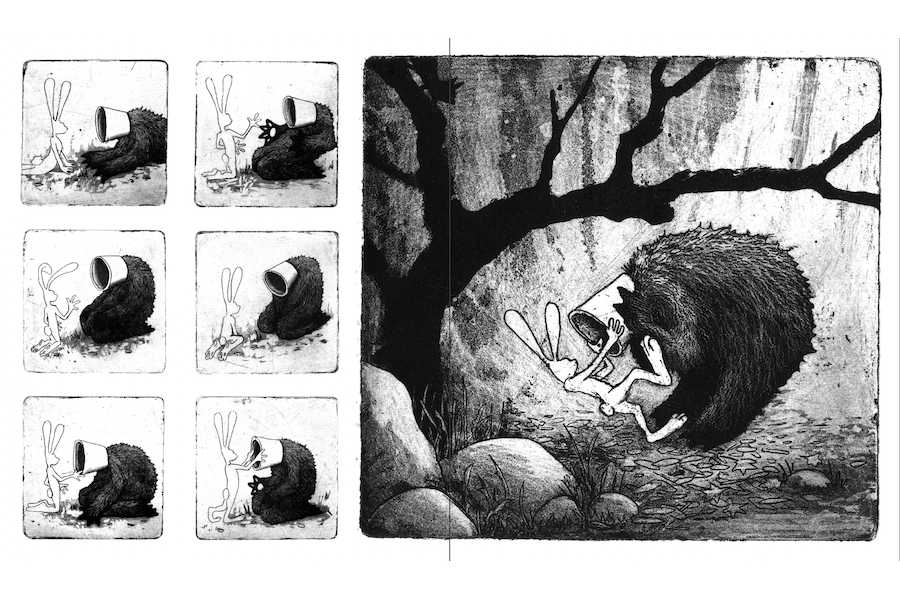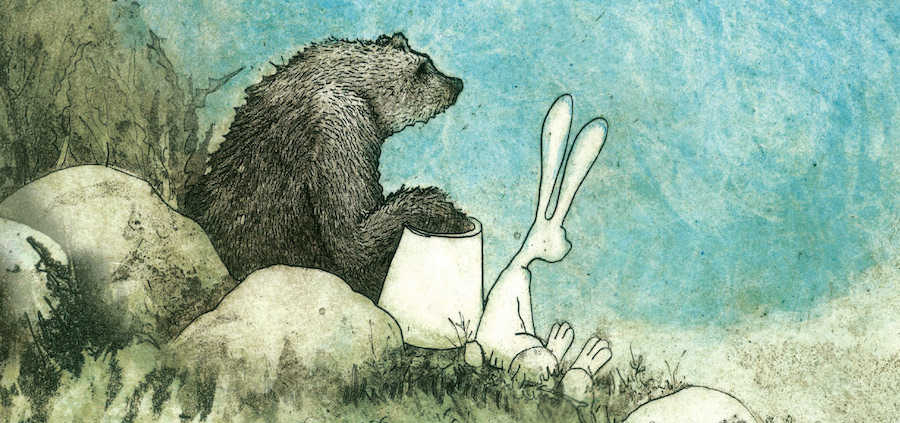Reading without Words by Nicole d’Entremont

bear
By Staffan Gnosspelius
Seven Stories Press, 2023
$19.95 80 pp.
I write but I also sketch. It’s another way to discover truth. It gets me away from words for a bit. We have so many of them all around us that we say, hear, read, and write. But the book I am reviewing, bear by Staffan Gnosspelius, only has images. You, the reader, supply the words.
There are two characters in bear: a despondent brown bear slumped in a thorny wood and a lanky, long-eared hare who chances upon the situation. The bear is hunched over and desperately trying to remove a “cone” fixed firmly around the neck. Think Dante. Think the Inferno. Think, “I came to myself in a dark wood where the direct way was lost.”
The bear is struggling mightily to get free from the cone—one of those devices clasped around the neck of a dog or cat after surgery and sometimes referred to as “the cone of shame.” But this is the original “cone of shame.” This is mental torment. This is depression. It is the primal “direct way lost” in psychological time. This is what Virginia Woolf was referring to in a diary entry when she wrote, “Now, the old devil has once more got his spine through the waves.” This is the story of “bear” depicted so wrenchingly in Gnosspelius’s etchings. Between the two characters, every conceivable mood and posture of curiosity, threat, entreaty, anger, submission, and resistance is explored. This is that story.
Perhaps this is not the book for you. Maybe you have never felt so forsaken in your own self or been witness to another’s suffering in such a way. But I think not. I don’t know how anyone in this world can be a feeling person and not have experienced this crucible in one way or the other. So, I will ask you to keep reading this review.

The effect of this book, on me, has been like a Rorschach test, a way to look afresh and engage my own emotional reactions toward the fact of depression. Gnosspelius draws, then etches, then prints with such craft and empathic artistry that it was impossible for me to look away.
As in Aesop’s Fables, the two subjects involved are a well-chosen match: a brown, single bear in deep trouble and a curious, solitary hare. Both are animals who don’t run with a pack, but after “stumbling” upon one another, their unlikely bond begins to form. Also, as in Aesop’s Fables, a lesson or moral is pointed to at the end, though I think the conclusion in bear is more nuanced than the morals of one of Aesop’s tales.
In my own reading of bear, I found myself drawn back more than once to individual illustrations, looking for clues as to the bear’s struggle and its possible cure, but none are directly given. It is all so private, that journey. It was only at the end that a key began to turn in the tumbler for me as a reader.
Endings don’t always have a neat conclusion and often hint at other potential beginnings, even if tentative, even if cautious. What I see in this book is great bravery and tenacity. And tenderness. Something we need today. It’s there in bear. I think you will see it. ♦
Nicole d’Entremont is a writer living on Peaks Island, Maine.





Leave a Reply
Want to join the discussion?Feel free to contribute!